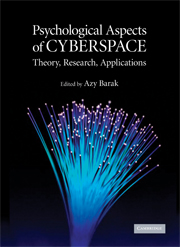Book contents
- Frontmatter
- Contents
- List of Tables
- List of Figures
- Preface
- List of Contributors
- 1 Reflections on the Psychology and Social Science of Cyberspace
- 2 Privacy, Trust, and Disclosure Online
- 3 Internet Abuse: Emerging Trends and Lingering Questions
- 4 Flow Experience in Cyberspace: Current Studies and Perspectives
- 5 Cybertherapeutic Theory and Techniques
- 6 Exposure in Cyberspace as Means of Enhancing Psychological Assessment
- 7 Down the Rabbit Hole: The Role of Place in the Initiation and Development of Online Relationships
- 8 The Sexy Side of the Internet: An Examination of Sexual Activities and Materials in Cyberspace
- 9 The Contact Hypothesis Reconsidered: Interacting via Internet: Theoretical and Practical Aspects
- 10 Influences on the Nature and Functioning of Online Groups
- 11 Online Motivational Factors: Incentives for Participation and Contribution in Wikipedia
- 12 How Internet-Mediated Research Changes Science
- Index
- References
1 - Reflections on the Psychology and Social Science of Cyberspace
Published online by Cambridge University Press: 05 June 2012
- Frontmatter
- Contents
- List of Tables
- List of Figures
- Preface
- List of Contributors
- 1 Reflections on the Psychology and Social Science of Cyberspace
- 2 Privacy, Trust, and Disclosure Online
- 3 Internet Abuse: Emerging Trends and Lingering Questions
- 4 Flow Experience in Cyberspace: Current Studies and Perspectives
- 5 Cybertherapeutic Theory and Techniques
- 6 Exposure in Cyberspace as Means of Enhancing Psychological Assessment
- 7 Down the Rabbit Hole: The Role of Place in the Initiation and Development of Online Relationships
- 8 The Sexy Side of the Internet: An Examination of Sexual Activities and Materials in Cyberspace
- 9 The Contact Hypothesis Reconsidered: Interacting via Internet: Theoretical and Practical Aspects
- 10 Influences on the Nature and Functioning of Online Groups
- 11 Online Motivational Factors: Incentives for Participation and Contribution in Wikipedia
- 12 How Internet-Mediated Research Changes Science
- Index
- References
Summary
Personal computers and computer networks began to take over offices and increasingly the public in the 1980s, but the extensive adoption of the Internet did not come about until the introduction of the first browsers and the overwhelming acceptance of Microsoft Windows and Apple systems – equipped with advanced graphics – both in the mid-1990s. The world changed in many ways for numerous people from that point, as both social institutions and individuals have witnessed and participated in another social revolution: the availability and accessibility of information of all kinds and the dramatic innovation in interpersonal communication. With the assistance and encouragement of governments and many organizations (acting out of a variety of reasons), computers, linked to ever-growing networks, penetrated the general public rather quickly and relatively easily. It did not take long before numerous technological firms around the world, acknowledging significant improvements in a broad array of personal, work-related, social, business-related, and government-related activities, joined a competitive race for this line of business, marked by its creativity and high potential. Accordingly, they advanced and reinforced more intensive use of computers and numerous computer-related activities. This race, in turn, brought about fantastic technological developments that have changed people's world order and lives in many ways, from seeking and using information on any topic to shopping and trading, from communication with acquaintances and with strangers to virtual dating and a love life, from learning and teaching to doing research, from helping others and being helped to improved use of medicine and other facets of health care, from entertainment and leisure to self-expression.
- Type
- Chapter
- Information
- Psychological Aspects of CyberspaceTheory, Research, Applications, pp. 1 - 12Publisher: Cambridge University PressPrint publication year: 2008
References
- 16
- Cited by



